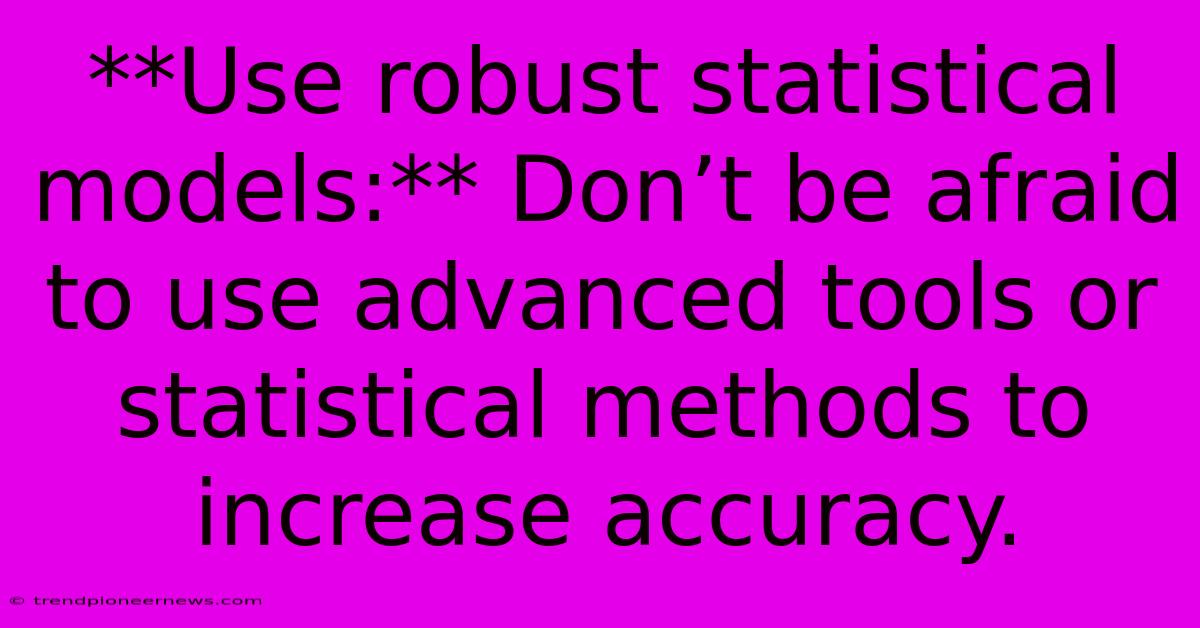**Use Robust Statistical Models:** Don’t Be Afraid To Use Advanced Tools Or Statistical Methods To Increase Accuracy.

Discover more detailed and exciting information on our website. Click the link below to start your adventure: Visit Best Website **Use Robust Statistical Models:** Don’t Be Afraid To Use Advanced Tools Or Statistical Methods To Increase Accuracy.. Don't miss out!
Table of Contents
Use Robust Statistical Models: Level Up Your Data Analysis Game
Hey everyone! So, I've been crunching numbers for, like, ever – and let me tell you, I've made some mistakes. One of the biggest? Being scared of "advanced" stats. I used to stick to simple stuff, thinking complex models were, you know, too complex. Boy, was I wrong!
This whole blog post is about using robust statistical models. Don't be a scaredy-cat like I was.
My Statistical Epiphany (or, How I Stopped Worrying and Learned to Love the Regression)
I was working on a project – predicting customer churn for a telco company. I was so proud of my initial model. It was simple, easy to understand, and… utterly useless. My accuracy was, like, 60%. Pathetic! It was embarrassing. My boss was not happy, so I had to fix it.
I finally decided to bite the bullet and learn some more advanced techniques. I started with multiple regression analysis. It's a bit more complicated than a simple linear regression, but it allows you to account for many different factors impacting your outcome. It takes time and effort to truly master the concepts of regression analysis.
Suddenly, my accuracy jumped to 85%! It was mind-blowing! I was ecstatic, my boss was happy, and I learned a valuable lesson: Don't underestimate the power of robust statistical methods. Seriously, sometimes the extra effort pays off big time.
Why Robust Statistical Models Matter
Using sophisticated models, like multiple regression, logistic regression, or even some fancy machine learning algorithms, isn't just about getting a higher accuracy rate. It’s about gaining a deeper understanding of your data. These methods can uncover hidden relationships and patterns you’d miss with simpler techniques.
For instance, with my customer churn prediction, simple models missed important interactions between factors like plan type, customer age, and customer service calls. My fancy new model showed that older customers with basic plans who frequently contacted customer service were significantly more likely to churn. That's actionable intelligence!
Tips for Tackling Advanced Statistical Models
- Start Small, Think Big: Don't jump into the deep end right away. Begin with something slightly more advanced than what you're used to. Master that, then move on. Baby steps, people!
- R or Python Are Your Friends: These programming languages are essential for working with complex statistical models. Learning either is a good investment. There are tons of resources out there. I highly suggest you use them!
- Don't Be Afraid to Ask for Help: There's no shame in seeking guidance from more experienced statisticians or data scientists. Seriously, we all need help sometimes. Collaboration is key!
- Focus on Interpretation: It's not enough to just run the model. You need to understand the results and communicate them clearly. What do the coefficients mean? What are the implications?
Conclusion: Embrace the Power of Stats!
Trust me on this – using robust statistical models is a game-changer. It might seem intimidating at first, but the rewards far outweigh the initial challenges. Don't let fear hold you back from unlocking the true potential of your data. Go forth and analyze! You got this.

Thank you for visiting our website wich cover about **Use Robust Statistical Models:** Don’t Be Afraid To Use Advanced Tools Or Statistical Methods To Increase Accuracy.. We hope the information provided has been useful to you. Feel free to contact us if you have any questions or need further assistance. See you next time and dont miss to bookmark.
Featured Posts
-
Odegaard Leads Arsenal To Champions League Win
Nov 27, 2024
-
Sporting Arsenal Highlights Match
Nov 27, 2024
-
Rod Stewart Glastonbury 2024
Nov 27, 2024
-
Sheffield United Oxford Channel
Nov 27, 2024
-
Oxford United 0 3 Sheffield United Full Report
Nov 27, 2024
